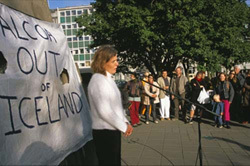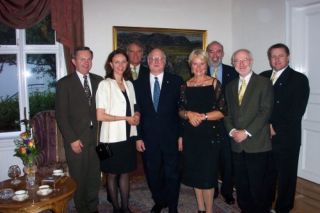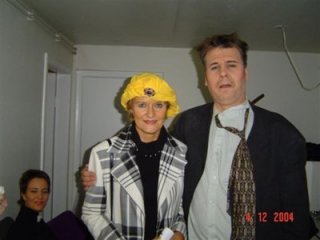Robert Jackson
So writes the poet and protester Elísabet Jökulsdóttir, and sitting in the board room of Landsvirkjun at a table long enough to hold a state banquet, it is hard to disagree with who is responsible for Kárahnjúkar. The walls of the ‘president’s floor’ have portraits of the men who in former times have managed the national power company.
Guðmundur Pétursson is a man of considerable experience. Having worked on a range of overseas projects, including in Venezuela, he is relaxed and congenial. Surprisingly so, for a man who is in charge of the billion dollar project and responsible for seeing that it is built on time and to budget. He has recently returned from a visit to China to the Yangtse River project, a scheme which dwarfs the Kárahnjúkar one.
“We are not displacing any people…”
“Our job at Landsvirkjun is to harness the country’s water power to generate electricity as economically as possible and then sell it overseas. And that is what we are doing at Kárahnjúkar. We are an island, we can’t export the electricity by cable so we have to work with foreign interests who are prepared to build in this country. Aluminium smelting needs a vast amount of electricity and we are able to supply it.”
When asked about the commercial viability of the project Guðmundur is in no doubt. “This project will have a long and successful future ahead of it and in comparison to other projects around the world, it has very small environmental impact. We are not displacing any people, we are flooding a wilderness area. When I take visitors to see the site most can’t see what the objections are about. The east needs projects like this and the benefits are being felt already. There are now four flights a day to Egilsstaðir, the hotel is building more rooms, the roads have improved, there are more shops and for the first time in years, property prices are increasing. The economy is taking off and there is optimism in the air. The project will make money despite what our critics say, we have done our sums and got them right.”
He is keen to focus on the engineering achievement and the sheer scale of what is being achieved, and he is proud of what he and his fellow countrymen are achieving.
Minister of Finance becomes manager of power company
The same upbeat message came from Tómas Sigurðsson who has been recently appointed by Alcoa. He dismisses out of hand the suggestion that Alcoa in someway benefitted from a soft deal with Landsvirkjun.
“This is the third power deal I have negotiated and I assure you it was not an easy task. We are paying a fair price for our electricity in a deal that works for both parties. We ourselves are investing hundreds of millions of dollars in building the smelter, which in turn will provide jobs and revenues for the country.”
For both these men Kárahnjúkar is a fait accompli. The government of the day voted with a significant majority to approve the project, the President in not using his veto gave his approval and subsequent polls done by Gallup show that over 65% of the country supports the project. Rivers are being diverted, mountains moved and tunnels dug.
But two years down the road, there is still deep resentment and bitterness as to how t he project came to be approved and concerns for its future viability. Criticism has been levelled at the government that the decision to proceed with the project was purely political in a tactic to secure seats in the east, and that once that decision had been made it was going to proceed, whatever the oppostion. If this was the case, then certainly its job was made a good deal easier by the appointment of the former Minister of Finance, Fridrik Sophusson, to the role of Landvirkjun’s Managing Director.
Do economic gains outweigh environmental concerns?
The same determination was apparent when the environmental issues were raised. There exists a Master Plan for Hydro and Geo Thermal Energy Resources and Kárahnjúkar did not originally receive a high ranking. Moreover, an environmental impact study carried out by the Icelandic Planning Agency in 2001 stated that “it has not been demonstrated that the gains resulting from the proposed development would be such to compensate for the substantial irreversable negative impact that the project would forseeably have.”
Siv Friðleifsdóttir, the Minister of the Environment, despite agreeing with the Planning Agencies conclusions, overruled the recommendations on the basis that “negative impact on the environmnet should not be weighed against economic benefit.” The weighing of the economic benefit was to be left to Landsvirkjun in the capable hands of a former cabinet minster reporting to the Minister of Industry and commerce Valgerður Sverrisdóttir. The fate of the most expensive, potentially prestigous and significant projects was effectively in the hands of two women, ministers Siv and Valgerður. A London newspaper, The Guardian, wrote six months ago:
“These two women’s CV’s were not reassuring. Valgerður´s only paper qualification seems to be an English as a foreign language certificate, awarded in 1972, and Siv is a qualified physiotherapist. Neither minister cites any parliamentary or other experience related to their portfolios.”
If, as the government proposes, the Kárahnjúkar project will be an economic success with negligable environmental impact, then Siv and Valgerður deserve the praise for steering a controversial project through parliament, whatever their qualifications and experience. If it is a failure, then Valgerður and Siv should be held accountable in same measure and questions should be asked in the future about the qualifications required to hold such demanding offices.
“I think a few won´t hurt”
It will take a number of years before it is known whether the scheme has been a success. In the meantime Valgerður is making noises of the desirability of another hydro and smelter project in the north and in an interview last April with Paul Fontaine-Nikolov, Siv made clear her unchanged views on the environmental impact of dams and smelters: “I don’t think the Kárahnjúkur dam should be a major environmental concern. It’s being built where nothing lives; it won’t endanger any species of wildlife. Aluminium plants can be good for the environment, at least here in Iceland, because most aluminium plants use oil or coal to power them. Such plants produce a tremendous amount of greenhouse gases. In Iceland, we can use hydroelectric or geothermal power. The plants also have to follow strict government guidelines regarding how much pollution they can produce. This makes the plants environmentally friendly. Of course, we don’t want to build aluminium plants all over the country, but I think a few won’t hurt.”
Already, other aluminium companies are queuing up to get the same lucrative deal Alcoa has. There is huge competition for the country’s slender resources, hospital wards are being closed and some public spending programmes are under review. The country has never borrowed so much money before and to launch headlong into another scheme without knowing the success of the current project would be to launch into the unknown. As with any addiction, a little can lead to a lot.
Grapevine.is


